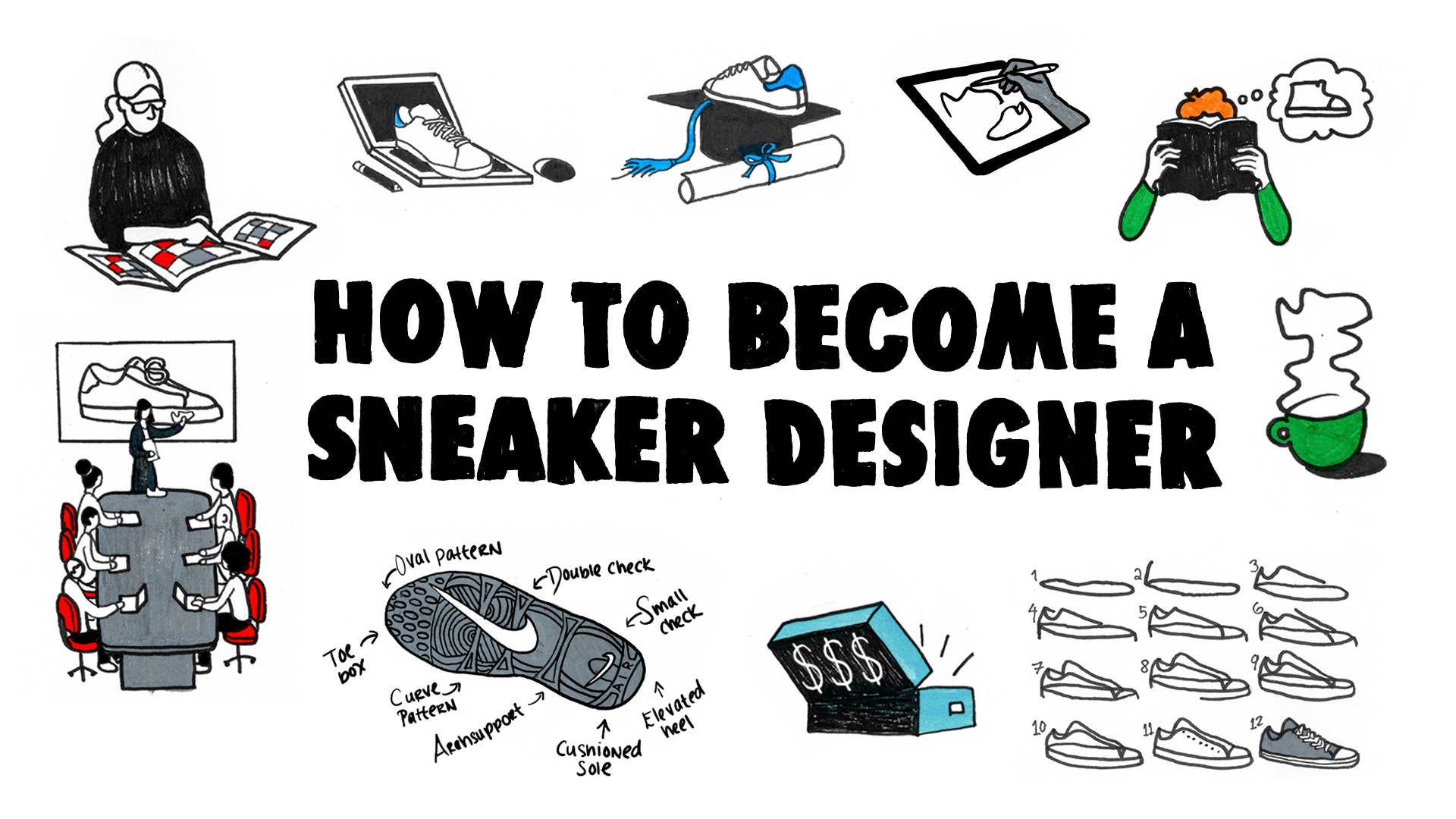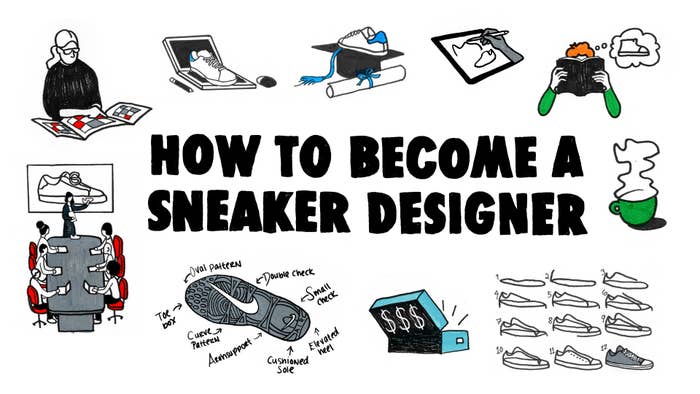
Image via Complex Original/Liam Eisenberg
Even after 18 years in the business, New Balance veteran Jonathan Grondin, the designer behind everything from World Series-worn baseball cleats to the Kawhi Leonard signature basketball line, still gets excited when he sees his creations on the feet of celebrities and star athletes. “It is amazing every time,” he says. Getting there, though, requires continued pursuit.
How do you become a sneaker designer? Draw with a purpose. Never stop learning. Understand the industry. Get your foot in the door. Intern. Take every opportunity. Gain a varied view of art and design. If you want to get a job making shoes, these are some of the steps to consider.
All illustrations by Liam Eisenberg
Start With Schooling
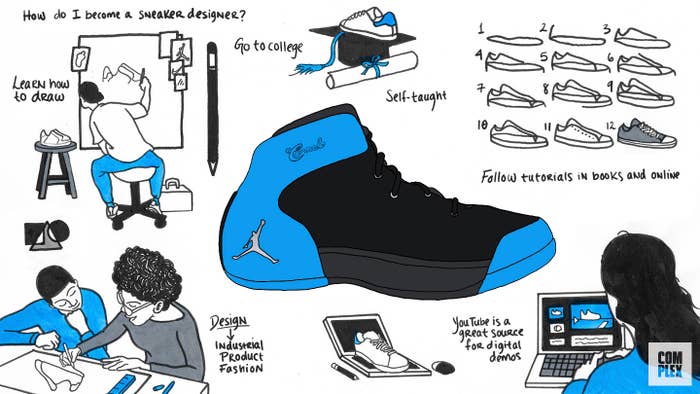
D’Wayne Edwards, a former Nike and Jordan Brand designer, helped would-be sneaker designers by founding the Pensole Academy in 2010, a Portland, Oregon-based organization that has now placed over 500 alumni in jobs in the footwear industry. But Pensole isn’t the only way, even if it is the most direct.
“It is a job that you really have to learn on the job,” Edwards says about why he started Pensole.
He also wanted to increase diversity in the industry, which is why Pensole isn’t a pay-and-you’re-in situation, but a school funded by brands in the footwear industry that requires you to get chosen. At Pensole, it’s about more than knowing how to draw—it’s about teaching students how to design. With classes sponsored by brands, Edwards says Pensole gives students 100 percent of what they need in the industry, and has become a place where brands look to grab talent from because they learn the entire process.
“Kids will post a pretty picture on Instagram, but as a professional, you see through the pretty picture,” Edwards says.
Sarah Sabino, senior footwear designer and Pensole alumni, got her start in the industry after graduating from Pensole’s second-ever class. Coupled with a fine arts degree from Massachusetts College of Art, she’s been in the industry merging her knowledge of art and creativity with her know-how learned at Pensole.
“You learn about color balance, texture, shape, form, and doing it with your hands,” she says. “You use those skills and apply in a different way as a designer. It has been really good for me and a perfect balance of my messy creative side and to clean it up in a design lens.”
Charlotte Lee, a six-year New Balance veteran and designer behind the popular New Balance 327, graduated from De Montfort in England. She landed an internship at New Balance before her full-time role and says she was fortunate to learn the skills she needed while in a dedicated footwear program.
Wilson Smith III, the Nike designer behind the Air More Uptempo, Air Jordan 16 and 17, the Pegasus 89, Andre Agassi’s and Serena Williams’ tennis shoes, and more, says Edwards offers an “outstanding” opportunity with Pensole, but it isn’t the only entry into shoe design.
Smith, like his contemporary Tinker Hatfield, was a trained architect before joining Nike.
“Shoes are very architectural, it made total sense to make that connection,” Smith says. “The world of design for buildings begins around the concept of form following function and that is important for anyone who wants to become a designer. Thinking about an end user and then creating products that work for that person, designing with that in mind.”
For those who haven’t gotten into Pensole, the industrial design degree is still the most common way into the sneaker industry.
“I’ve seen people who can do hot renderings, but can’t make that a real thing,” says Grondin, a trained industrial designer from Massachusetts College of Art. “It doesn’t matter how nice the drawing is if it is just a piece of artwork.”
Industrial design can give you the tools, teach you how to research, and how to build, helping merge the artist with the engineer.
Learn Everywhere
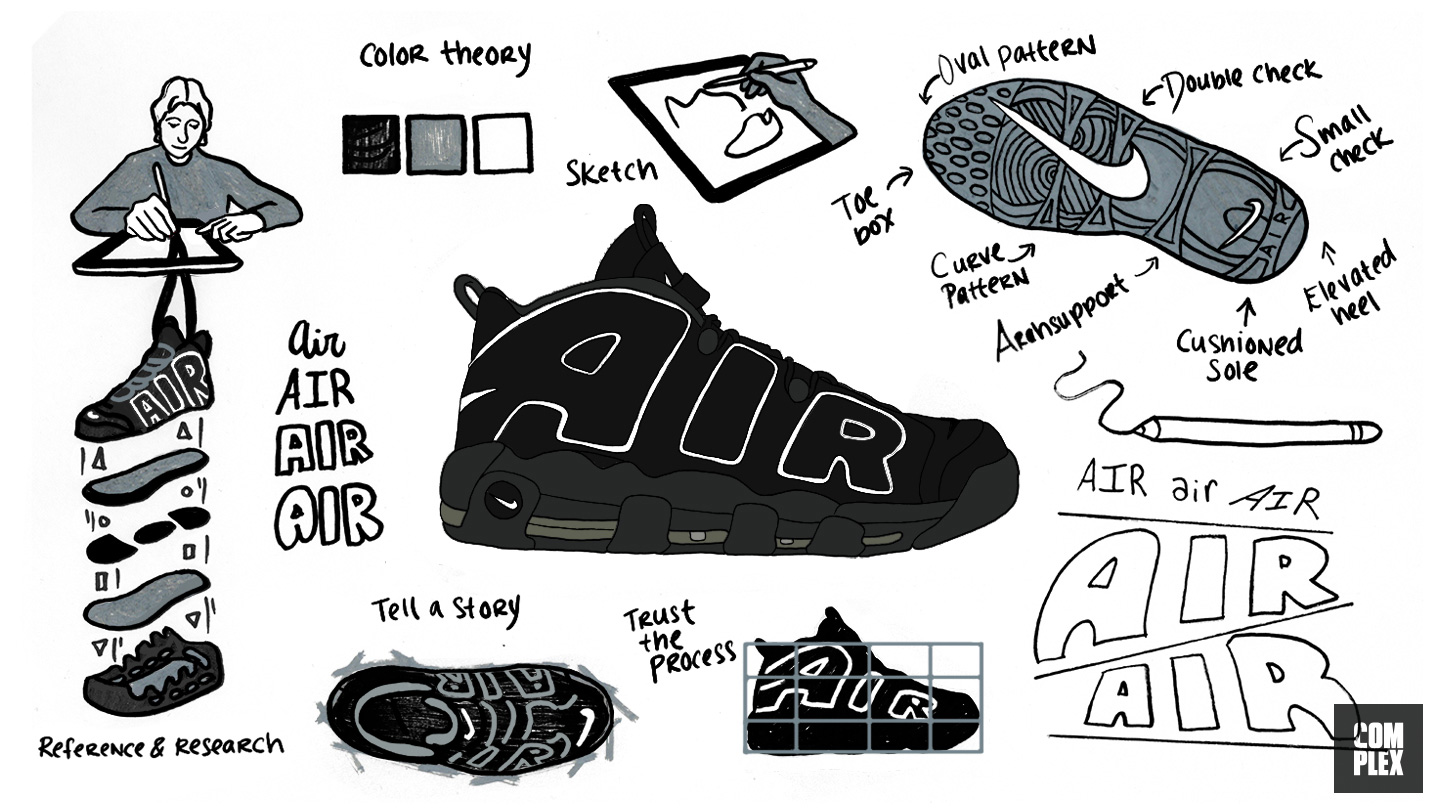
“When I started, my shoe probably looked like a brick,” Sabino says. “It was the idea of trying to learn and trying to go. That is the kind of perseverance and passion you can’t teach people.”
Sabino encourages would-be designers to build a digital portfolio and message people at brands to ask about their stories and journeys.
“For me, coming from a fine arts background, it isn’t cookie-cutter industrial design, white, male, fast-line drawing,” she says. “For kids to know you can be different and have a different point of view and love something and get a career in that, it puts the ‘possible’ in ‘impossible.’”
Broadening your understanding is key, Smith says.
“I see great opportunity studying for a product design degree and other areas of design, in particular architecture,” he says. “Shoes are homes for the feet. When I am designing a shoe, I am thinking of a particular facade or exterior expression.”
Having this growing understanding of design can help with your take on shoes, Smith believes. When working on the Air Jordan line, he was able to tap into both Jordan’s love of music and his own knowledge of the art of jazz—the style of music Jordan was most interested in at the time—to build a shoe focused on improvisation. His knowledge of calligraphy helped him come up with the essence of the Nike Air More Uptempo basketball shoe within 20 minutes, because he understood the shapes of the letters. When working with Serena Williams, his awareness of fashion led him to focus on her love of boots for her first Nike shoe in 2004, a design that turned heads during the US Open.
“When I design a product, I am thinking about so many different worlds of design and they all help influence a brand-new way of thinking,” he says. “It is so important for a footwear designer to really learn about everything else in the world of art and design and have a diverse background of interests and pursuits. If you limit it to shoes, it is not a broad enough reach. I am often looking for something outside the world of shoes to inspire shoes.”
Grondin says to start as early as possible and never slow your learning. If you want to design performance shoes, cut them apart, absorb the materials and their purposes. And after you draw something, try to make it—not for use, but for understanding—out of paper or cloth, to better comprehend sneaker construction. His first job within New Balance was designing the 906 trail shoe in the early 2000s. “I didn’t think life could get any better,” he says. From there he has stayed focused on solving problems, especially in performance spaces.
“Everything needs to have a point of view,” Grondin says. “You don’t draw the hot rendering and walk away.”
How to Start
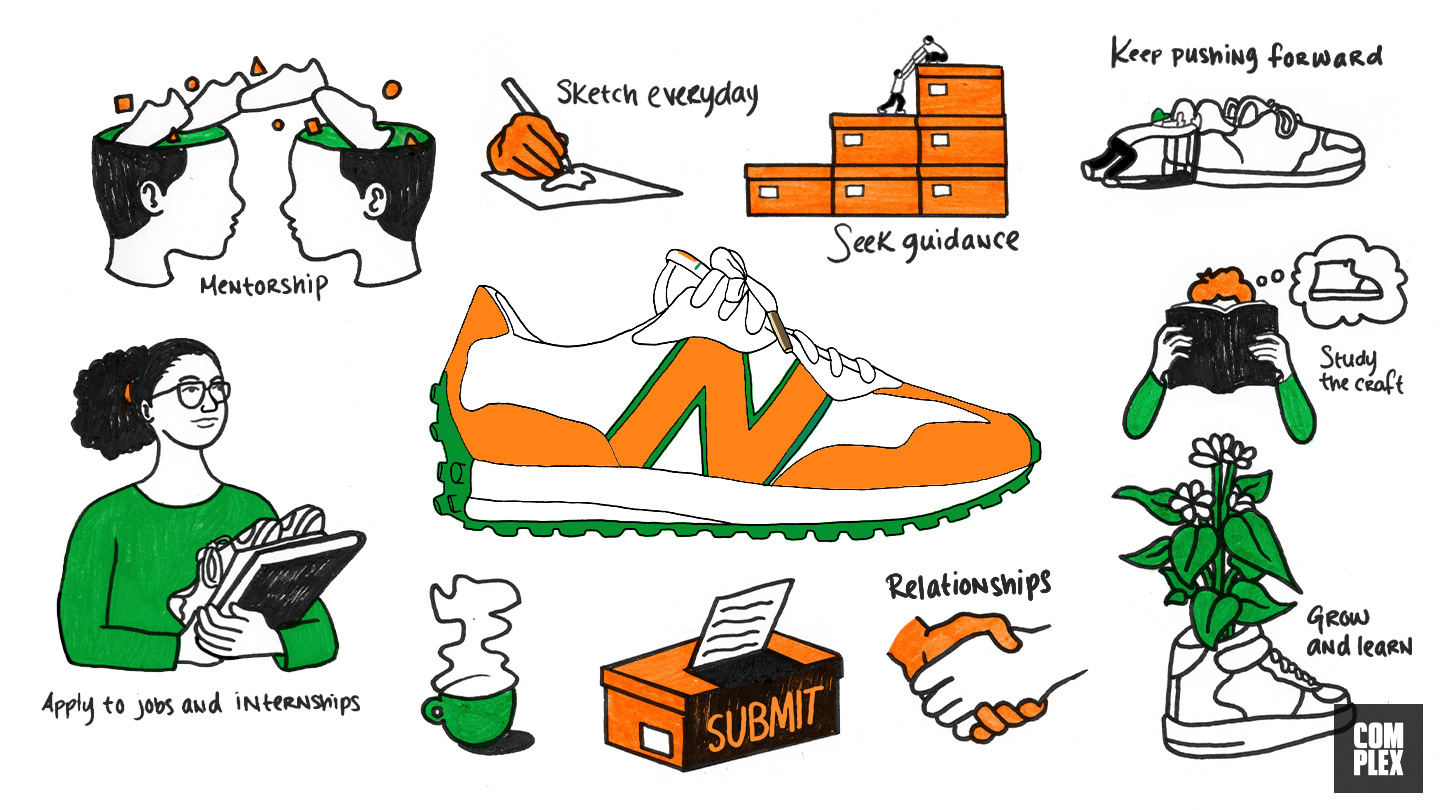
Edwards says he understands young inner city students, those in middle school and high school, may not always have access to art, especially relevant art. And while he wants to improve school programming, he encourages kids to understand patience can make them better.
“Draw anything you can see and try to make it look exact,” he says. “It is all about repetition.”
Just like a basketball player learning the game, you can’t shoot threes or throw a pass behind the back without mastering the basics, Edwards says, adding that “the digital tools are ruining kids if they don’t know how to use them. If you jump straight to Illustrator or Photoshop, but can’t sketch it, you are skipping a few steps.”
Sabino entered contests before getting a spot at Pensole. It was from there she landed multiple internships before gaining a full-time job.
Smith says designers are curious by nature, so “pursue all aspects of creativity as you are coming up through school. It could be calligraphy, pottery, sketching, art, all of it aligns with design. It is all exercising the same design muscles.”
At New Balance, Grondin says there are plenty of different paths to design, from trained industrial designers like himself, to architects, graphic designers, or artists. He says online contests are great early on, giving you the needed skill of learning how to take feedback.
“Intern, intern, intern,” Lee says. “Anything I could get to get my foot in the door.”
She did week-long internships, month-long internships. And all the while, she suggests learning from those around you, initiating conversations, and sketching a lot.
“I think a lot of people get hung up on amazing concepts,” Lee says. “If you look at my sketches, they are little scribbles on Post-It Notes. It is about being able to transcend that into a product.”
Through it all, draw with a purpose, solving a problem.
“Start thinking about a problem you need to solve for and really take that concept and don’t hold back,” says Alex Restivo, 11-year industry veteran formerly with Nike and now with Converse. “Explore outside the lines of what is traditionally seen.”
What If I Can't Draw?
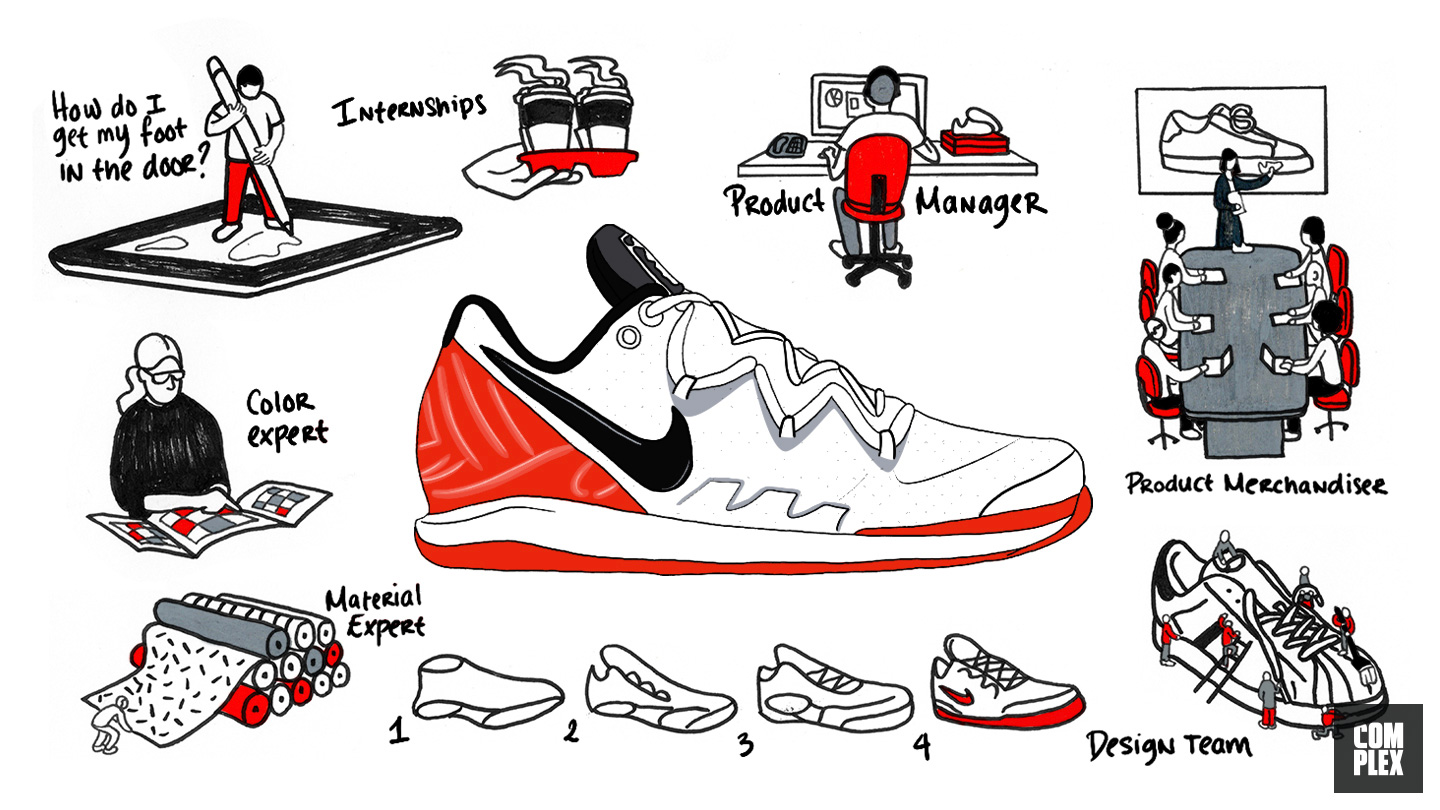
There are still plenty of homes in the sneaker design world for those who can’t draw. Product managers, product merchandisers, and color or material experts are all jobs on the same team as the sneaker designer.
“Someone who cannot draw but has really good ideas can partner with someone who can draw and have them take the vision of what you have in your head and put it on paper—that is product merchandising,” Edwards says. “That is a job in a company.”
Materials and color experts have a place, as do people turning a designer’s sketch into a 3-D object. The product developer puts it all together and works with the factory and engineers to make a physical prototype. Then there’s the product creator, “the person who can’t draw, likes to tinker and MacGyver shit, make the prototype and samples,” Edwards says. “You have all these jobs within product creation. Your life doesn’t have to stop at being a footwear designer. Our industry does a horrible job of telling the world there are all these other options.”
Restivo, a marketing major and industrial design minor at Syracuse, crossed two worlds in school and now focuses on making “good product decisions based off the marketplace and business needs” in his role as a product manager. After an internship at Nike led to a job, he’s made a career out of it.
“Product management was a very eye-opening position for me,” he says, adding that it allows him to be creative and focus on business without forcing him to be a world-class artist.
The Other Skills
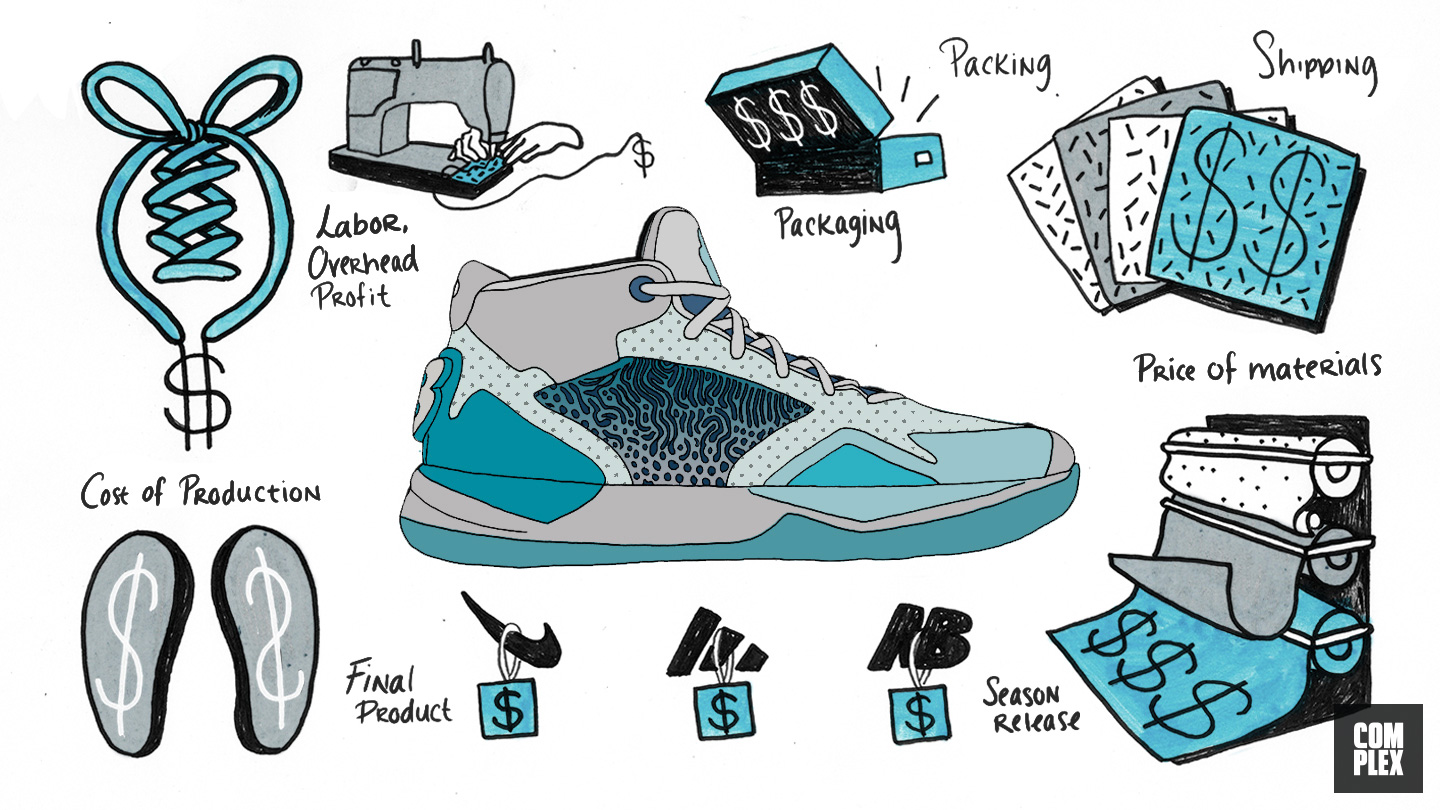
Edwards says Pensole teaches both the hard skills of footwear design and also the soft skills of working together as a dependable professional.
Knowing about more than drawing helps you create product. Early on at New Balance, Lee designed a low-cost kids’ running shoe. It wasn’t a high-profile project, but taught her about the process and making decisions, leading to projects like the popular 327.
The biggest thing Sabino had to learn was working with a team. When you’re in high school and put in a group project, learn from the group’s different backgrounds and skill sets to work toward one goal.
“It is a life skill you should work through,” she says. “It is the corporate environment that is the day to day. Work and grow from each other.”
Grondin says presentation skills matter.
“You need to tell me I drew this shoe like this because of this and it goes together like this and costs this much to make it,” he explains.
The secret the sneaker designers don’t want to tell the hopefuls in fear of scaring them away: their days are 90 percent meetings. Sneaker design is about details, precision, and communication, all mixed in with a bit of creativity.
Most of all, believe.
“I can’t emphasize enough having a vision and a passion and continuing to stick with that,” Restivo says. “Knowing the right people, getting involved in the right education and internships, accepting positions that are a means to an end, being open-minded, as long as you are within the industry and vocal about what you want to do in your career, you will get there.”
SHARE THIS STORY

